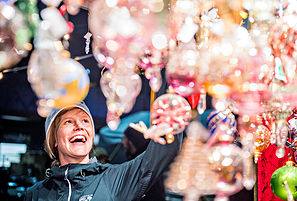
Beautiful succulent plants, herb garden, bamboo, children’s garden, and many other fun plants at The San Diego Botanic Gardens
Have you had the pleasure of seeing San Diego’s lush plants at the San Diego Botanic Gardens (website)? I had the good fortune to tour their 26.5 acres of plants, which include plants from regions afar, including New Zealand, desert, tropical, California natives, herbs and a children’s garden.
The garden started as the home of Ruth and Charles Larabee in 1942. It’s situated on a small hillside area in coastal California, near Carlsbad, California (actually in Encinitas, CA). In 1957 it was donated to San Diego county to be preserved as a park (originally named Quail Gardens).
The coastal locale means that plants get the warm sun and moisture, but the intense, drying desert sun is not as scorching to tender plants. Fog and clouds moderate the sunshine.
Prehistoric Plants:
And this plant, African Cycads, have their own notoriety: it was present at the time of the dinosaurs!! This means that not only did it survive, but that this pocket of land had similar weather for millennia. Often the land and weather change through continental uplift, asteroids, glaciers coming and going, volcanic eruptions spewing ash that causes cloud cover for years…You get the picture.

Cycad plant, a prehistoric plant from the dinosaur age
African Cycads’ spiny exterior are thought to have protected it from foraging animals in present (rhinos) and times long past (dinosaurs). These cone-producing plants (see photos) are believed to be distant relatives of tall conifers like redwoods and cypress. Today they are endangered from agricultural land use, animal grazing, and over-harvesting.

Cycad with cone, a relative of modern conifers
Cork Tree
In the pre-rubber days, cork was used extensively for many things, including wine stoppers, flooring, car cabin noise insulation, anything that needed a pad against wear or vibration, and car head gaskets (that join between the two halves of the motor, sealing them). During World War II, the cork supply was threatened, and it was a patriotic duty for Americans to plant these cork oak trees (Quercus suber). (See, plants can be important in history!) When our guide mentioned WWII and the cork supply being threatened, I was thinking of Southeast Asia around Japan (oops!).

Cork Oak Tree: A sustainable tree that offers its cork from its bark. The supply was endangered during World War II. (I tried and tried to rotate this photo, but couldn’t get it right.)
This online source (Wikipedia) says that the harvesting is renewable, because the bark is peeled off, and the tree itself left to continue grow. Apparently, a new layer of bark grows. (Most other trees are harmed by removing the bark, as it feeds the tree.) It can be harvested every seven to ten years.

Close up image of cork oak bark
It’s native to Northwest Africa and Southwest Europe. Forest fires give an advantage to this Cork oak trees are protected from forest fires, allowing it to continue to grow and spread its canopy. Other trees die and regrow from seed, or regrow from the base root. This means they are in the “shade” for several years while they catch up.
The bark looks funny, as you can see from the photo, and feels like cork to the touch. It’s slightly spongy.
Bamboo Garden:
There are many varieties of bamboo here. We learned a great deal from a cart driver and docent (who kept vouchsafing that he was not a tour guide). For instance, many areas of California have a problem with bamboo spreading underground and taking over. It’s so serious, that some friends spread concrete across a 6′ by 25′ area to stop neighbor’s bamboo from overtaking their yard. I learned from our intrepid guide that there are two kinds: corm and riser. CHECK The riser kind is the one that spreads, causing California nurseries to advise planting only in pots.

Bamboo Gardens

Bamboo garden varieties
The bamboo seemed very lush and pretty. The corm variety is what they plant in the botanic gardens– they don’t spread unchecked. Rising up thirty feet in dark green hues, it reminded me of a scene from a Chinese film I had seen. People stood ten feet up on bent bamboo stalks (with the help of wires), that ultimately rose sixty feet high or more, as soldiers fired waves of arrows at them. (See the 5th photo down on this web page, from the film House of Flying Daggers, I believe. View more on the IMDB.com film page photos.)
Desert Garden:
Succulent plants store water in their thick “leaves” that look more like blue or green, smooth branches. At least, they are smooth where there aren’t any spines. The leaves sometimes feel cool or waxy. There are many varieties, as you can see in the photos below. Amazing colors, aren’t there?
Check out this yucca plant below. It’s bigger than me!! It just bloomed, and there was a “candle” (flower stalk) on the ground. The plant will die soon, and it’s progeny will sprout up.
Here’s something creative- succulent plant topiary!!

This is a desert topiary, made from succulent plants.

Doesn’t this plant remind you of Georgia O’Keefe’s close-up flower paintings? Did you notice the color variations?
Herb Garden:
As an herbalist, I enjoyed touring their herb garden, which included Heal All or Self Heal (Prunella lacinata or in my books, called P. vulgaris), an herb that I have yet had the pleasure to use. From the name alone, It had great importance to home herbalists.
One herb source^ quoted a 16th century herbalist as saying,
there is not a better wound herbs in the world than that of selfe-heale.[sic]
This source claimed it is antioxidant, and would be beneficial for inflammatory bowel diesease, diarrhea, sore throats.
An herb book by Skenderi* says it has antibacterial and antiviral, wound-healing, astringent (dry/tighten), and bitter tonic properties. It’s used as a tea for digestive and mouth inflammations, and for external sores.

Heal All herb at The San Diego Botanic Gardens, in California, USA
Woodland Germander was also there, which had feathery leaves coming off a low, sprawly central stalk. Germander was used historically in herbal medicine, but apparently there are concerns now (with modern testing capabilities) that it could be toxic to the liver. The genus and species are Teucirum chemaedrys and others. It’s in the mint family (Lamiaceae).(*Source)
Aren’t the pink blooms see below lovely on this Nutmeg Bush (Iboze riparia) ? What do you think?

A flowering nutmeg plant at The San Diego Botanic Gardens, in California
I love looking up commonly-used kitchen herbs. There are always fun surprises when you find out your favorite herb can be used for serious herbal medicine.
Besides its use in desserts and some pastas, nutmeg is also supposed to have these properties: antispasmodic, anti-gas, good for general stomach issues, anti-inflammatory, and anti-bacterial.*
In India, its considered an aphrodisiac, and the same tree is also the source of mace.^
There was a warning about not using it during pregnancy and lactation, nor mixing it with anti-depressant drugs and herbs like St. John’s Wort. And – stranger even – there was a warning not to use it in high doses above 5 gms, due to its ability to cause drowsiness, hallucinations, headache and confusion.* Who knew?!
Children’s Garden
The Hamilton Children’s Garden has a cool man-made tree house, with plants that get their moisture from the air covering its branches. It’s looks super fun, with rope bridges in places and more.

Tree house at The San Diego botanic gardens in California

Sorry, more technical difficulties in turning this photo!
There are also alphabetical plant exhibits, with the letter J by a plant that starts with the letter “J”, for instance.
Have you visited this garden? Let me know in the comments below.
If you enjoyed this article, please share it with your friends, using the social media buttons below.
Want to sign up for our newsletter? Includes healthy recipes, nutrition and herbalism tips, and more. It’s free, and once a month. Just click here to sign up in 10 seconds.
And check out my online course, Raising Your Immunity Through Herbs, Nutrition and Lifestyle Methods. Here’s a course coupon, too! Thanks!
Sources:
*Gazmend Skenderi’s Herbal Vade Mecum, Herbacy Press, 2003
^Andrew Chevallier, Encyclopedia of Herbal Medicine, DK Natural Health, 2000








